March’s Fungi Focus: Split Porecrust and Cinnamon Porecrust
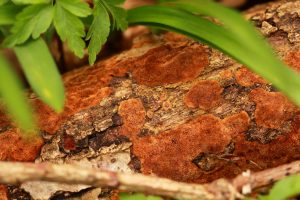
There are many reasons why resupinate or crust fungi fail to attract much in the way of love or attention even among fungi fanatics. For starters, there are hundreds of different types, and the vast bulk of them are incredibly difficult to identify, lacking that one significant feature amongst other identifying criteria such as colour and habitat: a three-dimensional form. They instead appear as flat blotches, skins or coatings of various hues and textures, and mainly on dead standing or fallen trunks and branches, sometimes parasitizing living wood.
Furthermore, there are large overlaps between separate species when it comes to their more salient physical attributes, like the varying colorations or the feel and finish of these spore-releasing surface areas, known as hymenium. One can’t deny it, but the vast majority look very, very similar. Flicking through the near 380 or so pages – containing around just as many species – of Paul Hugill and Alan Lucas’ dedicated guide to The Resupinates of Hampshire (mentioned this time last year in my post on one of the most readily identifiable, the Hairy Curtain Curst ), or even the hundred odd pages devoted to them in volume two of Thomas Laessoe and Jens Petersen’s Fungi of Temperate Europe, one can’t help but wonder whether anyone involved in compiling these books would have noticed if the photos had been mislabelled and mismatched with lookalike species...
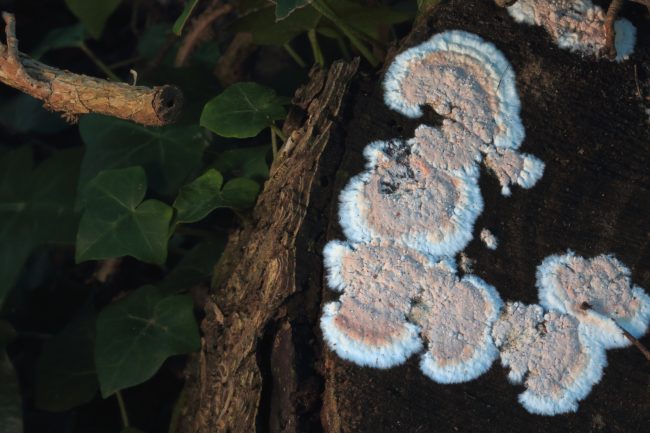
The vast majority of crusts are nigh on impossible to identify without use of a microscope
One might also note a certain opaqueness in the vocabulary used to describe their macro features. Where might the dividing line lie between such adjectives listed in Hugill and Lucas as ‘merulioid’ (“folded, wrinkled surface”) and ‘colliculose’ (“small undulations”)? Or ‘hydnoid’ (“having toothlike or spiny projections”) and ‘odontoid’ (“having short blunt spines”)? Or ‘arachnoid’ (“cobweblike”), ‘athelioid’ (“cobwebby, as a thin detachable membrane”) and ‘reticulate’ (“having a netlike pattern”)?
To be honest, for a lot of species, without access to a microscope you might as well not even bother trying to identify them, making resupinate fungi perhaps the final frontier for those hardcore few wishing to show off their mycological mettle through their ability to attribute a Latin name to what most might view as an unremarkable smear on a rotting log - a feat rendered all the more challenging in that these ‘official’ Latin names also seem to change on an alarming basis!
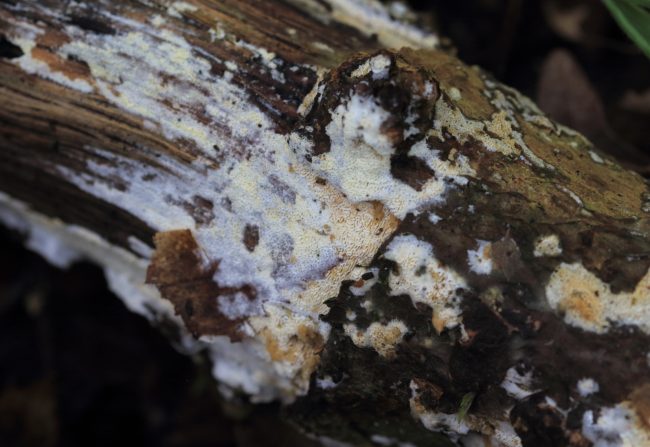
An anonymous smear on a rotting log, or is it Schizopora paradoxa?
Many might consider their time far better spent on more fruitful woodland activities. Not I, however. For those bitten by the fungi bug, the world that can be discovered beneath rotting logs or on fallen branches offers up manifold challenges and rewards. There is something smugly satisfying about knowing you are the only freak in your neck of the woods who can differentiate between a Wrinkled Crust (Phlebia radiata) and a Jelly Rot (Phlebia tremellosa) at first glance, or who finds a genuine thrill in uncovering the microscopic details that distinguish a Rosy Crust (Peniophora incarnata) from a patch of Tear Dropper (Cylindrobasidium laeve).
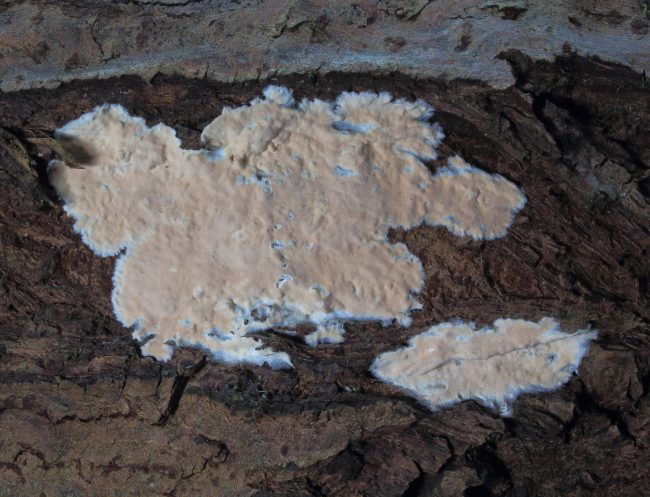
Cylindrobasidium laeve, or the Tear Dropper, is a typically featureless example of a corticioid resupinate fungi
This is an area where, I’ll have to admit, I will forever feel like I am only just dipping my toes in the water, deferring to the expertise of a handful of others such as those who frequent the British Mycological Society Facebook page or the even more select members of the Crust fungi and polypores group.
Resupinates offer one significant point of attraction, however, in that they can be found throughout most of the year, when our more familiar mushroom types are still lingering in their mycelial form hidden within their substrates. Even if these crust-like fruiting bodies have ceased releasing their spores, most are remarkably durable and tend to hang on for a couple of months, sometimes longer. Take for example, the ubiquitous Elder Whitewash featured in this post from last year. The recent dramatic storms, floods and howling gales have brought many down to ground level on windfall branches, making them an apt area to revisit for a March fungi focus, in which I offer a brief introduction to a couple of the more common and least challenging types.
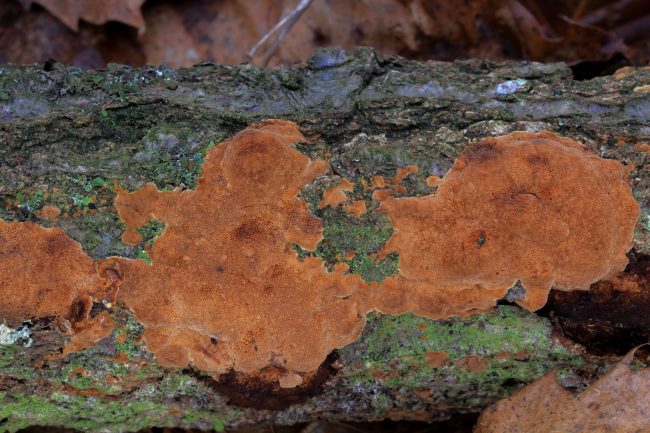
The poroid surface and cinnamon colours of the Cinnamon Porecrust
One simple dividing line can be drawn with these types, and that is between resupinates with a relatively smooth and featureless hymenium, the corticioids, and those with pores rather like the underside of bracket fungi, the poroids (let us ignore the Hugill and Lucas distinction between ‘poroid’, or “having a porous surface as the fertile layer”, and ‘porulose’, or “finely poroid in appearance”).
Turning our attention to these poroid types, one might notice under the lens how remarkably similar they are to bracket types like Birch Polypore or Dryad’s Saddles. There is really no genuine division between brackets and crusts (as emphasised by the example of Hairy Curtain Crust): many bracket fungi can grow in resupinate form depending on the orientation of the substrate they are growing on – I present the Common Mazegill (Datronia mollis), as an illustrative example here, but this is a subject I shall return to in a future post.
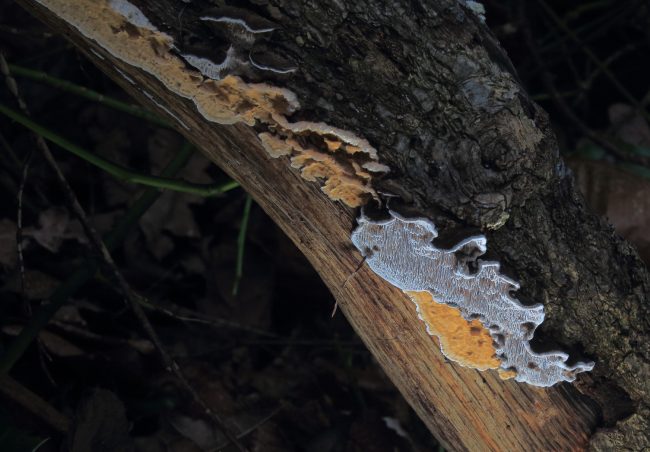
This Common Mazegill forms brackets or, in this case, a more resupinate form growing on the underside of a fallen branch, where it appears alongside a more obviously crust-like Stereum species. Thanks to Emma Williams of the BMS for the identification).
Conversely many so-called resupinates will form shelves if growing from a vertical surface, such as a standing tree trunk, or their edges or margins might raise or curl up from their substrate to form distinct shelves or caps. Brackets and poroid resupinates should never be considered distinct in any true scientific or taxonomic sense.
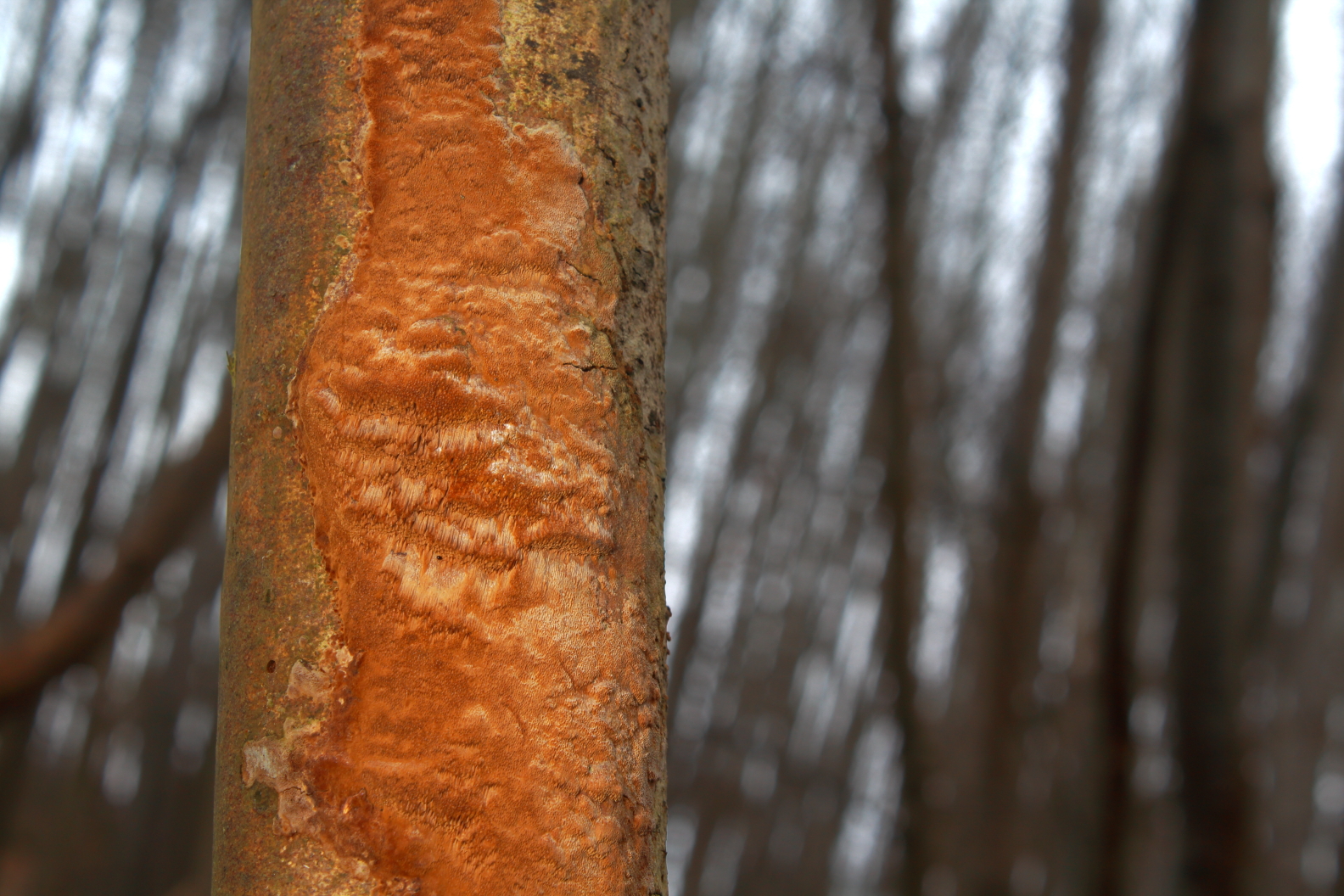
Cinnamon Porecrust growing from a vertical dead tree trunk, forming shelf-like overhangs with the pore tubes facing downwards
There is, however, a sizeable section on ‘Annual, resupinate polypores’ in the Fungi of Temperate Europe, that feature about 20 pages of “polypores with annual, flat fruiting bodies that completely lack caps… all species are wood-degrading and produce a white rot”. As the text points out, this is a really difficult group to negotiate your way around, and “correct identification requires microscopy”.
Most people will not possess a microscope of sufficient oomph for the tricky task of seeking out these otherwise invisible identification features (up to 1000x magnification with an oil immersion lens), but don’t despair quite yet. There are other features that can point towards positive identification. What colour and how thick is this crumpet-like surface? Is it soft and rubbery or more tough and woody? Does it peel easily from the wood it is growing on, or is it more firmly embedded in its substrate? What does it smell like? What type of wood is it growing on? Does the poroid surface stretch right to the edges, or is there a conspicuous margin, and if so, is this margin a different colour, is it cottony and white, or it cobwebby with obvious hyphal chords? And the pores themselves - are they small or large? Are they uniformly round or angular? Are they irregularly sized and shaped?
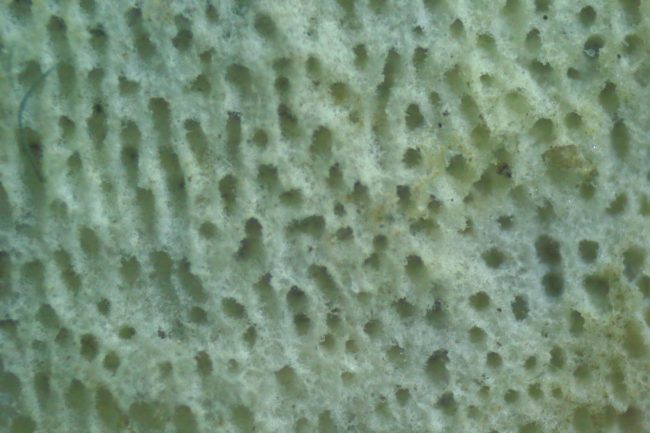
Detailed picture of the poroid surface of a Split Porecrust
Obviously, some species are considered a lot rarer than others. This might be because they are less frequently recorded by those undertaking such scientific surveys, or perhaps they are frequently mis-recorded as something else. I, however, am going to turn my attention briefly now to two types that I have found quite a lot of over the past year or so, and which I have honed my own eye enough to be fairly confident I have identified correctly.
The first of these is the Split Porecrust, or Schizopora paradoxa, which can be found mainly on fairly well-decayed deciduous wood lying at ground level, appearing initially as small and rather thin patches of white to a cream or light buff colour that fuse to cover much larger areas. The pores are rather small, with The Resupinates of Hampshire describing 1-3 appearing per millimetre. If you look under a hand lens or through a photographic closeup, you can see they are quite angular, or “lacerated” as the book puts it, although the species is “very variable in appearance”. Essentially the reason for this seems to be that the pores grow downwards, so if viewed straight on from the side, they can appear more irregular and sharply delineated, dangling “almost as flattened teeth”, or “dentate”, as its entry in The Fungi of Temperate Europe puts it, presumably accounting for the common name of this fungi.
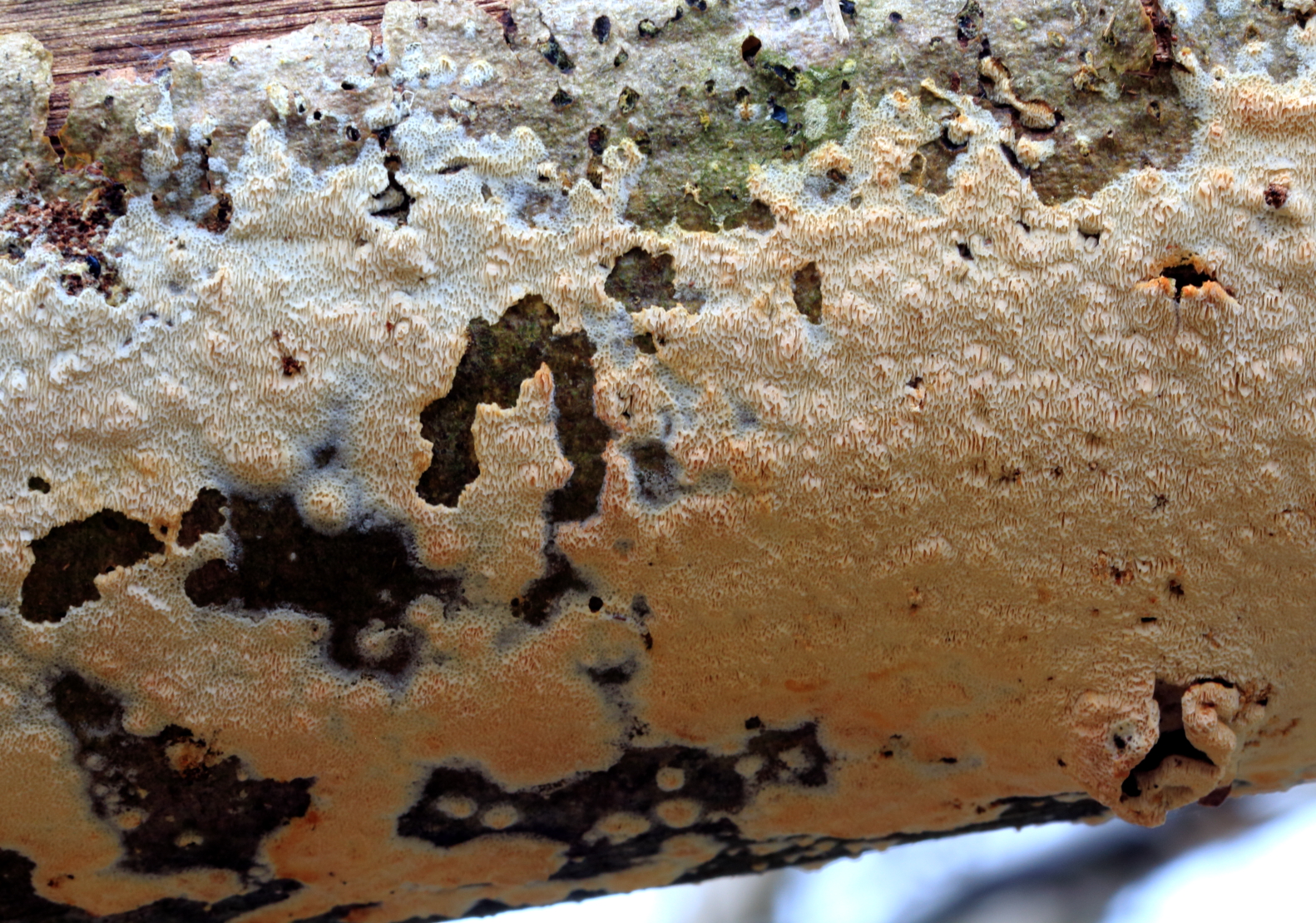
The irregularly-shaped pores of the Split Porecrust growing downwards like teeth
The Fungi of Temperate Europe lists the species under its Latin synonym Xylodon paradoxus, and both books show photos of a number of species that look remarkably similar. Schizopora radula (or Xylodon raduloides) seems to be a lot thicker, with its surface up to 5mm thick, and with slightly larger pores (with the emphasis on the word “slightly”), while those of Schizopora flavipora (or Xylodon flaviporus) are apparently slightly smaller and more regular. I’ll just mention in passing, too, that there are members of at least one other genus, Antrodia, that share superficial similarities with Schizopora.
If you find yourself glazing over at this point or feel like throwing up your hands in frustrated despair, please don’t. These second two are both described in Resupinates of Hampshire as “rare”, while Schizopora paradoxa is described as “very common”. If you do find anything that looks like the photos here, I doubt anyone one is going to think any less of you if you refer to it simply as Split Porecrust.
If you are, however, the type of person to lose sleep over such things, you’ll need to resort to the microscope. I am and I did. After cutting a thin sliver from the surface and laying it down on a slide with a wet tissue on top of it, I was able to locate some spores, whose size and shape pointed towards this most common species (“Ellipsoid, smooth, thin walled, containing one or more oil drops, hyaline. 6-6.5 x 3.5-4 microns”, and therefore a tad larger than its relatives, according to Hugill and Lucas). There are other microscopic details that would further confirm this hypothesis, but this was enough to satisfy me at least.
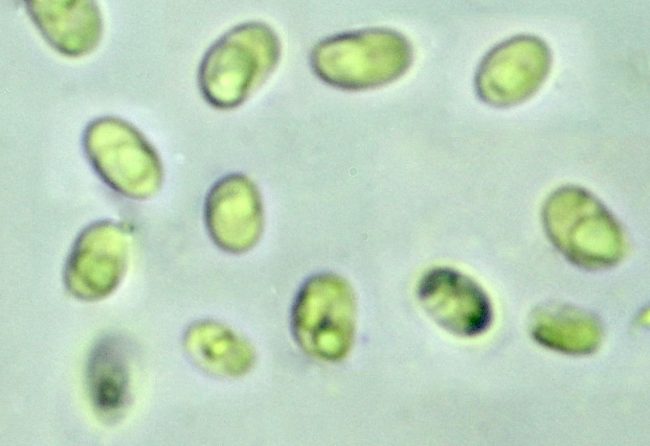
The spores of Schizopora paradoxa, with visible oil drops inside them
There is another common poroid crust that lends itself to fairly easy identification. This is the Cinnamon Porecrust (Fuscoporia ferrea), which as the name suggests, is russet brown in colour. It goes by the alternate common names of Iron Porecrust, presumably in reference to its rusty hue, and Suede Polypore, due to the way it forms a tough dry leathery crust that is not easily removed from its substrate on fallen tree branches (on a wide variety of trees), coming across as more like an outgrowth of it. The pores on this are much rounder and much smaller than Split Porecrust, but it is still a very distinctive species.
Of course, things are never quite as simple as they first seem. Aside from having an alternate Latin name of Phellinus ferreus, a fact which needn’t trouble one too much, it also has a lookalike in the form of Fuscoporia ferruginosa (or Phellinus ferruginosus), also known as the Rusty Porecrust.
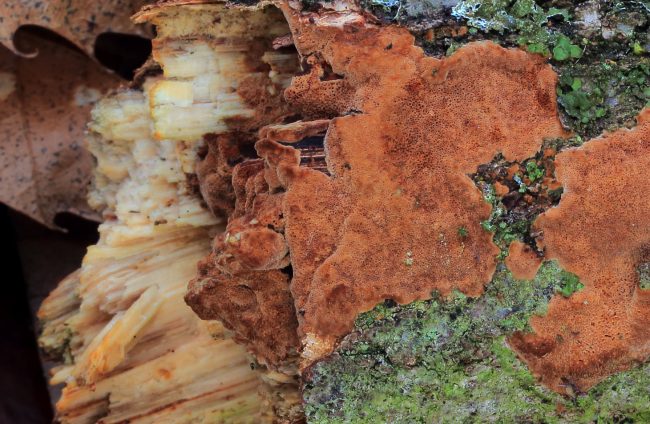
Like a suede pommel on the end of a fallen branch, a Cinnamon Porecrust
This distinction at the level of common names is rather strange, especially considering that the vast majority of crust fungi only have Latin ones. I doubt there is anyone outside of the real mycological diehards who could distinguish between the two with the naked eye (nor who would see any need to). Again, to all and intents and purposes, us mere mortals might be happy treating the Cinnamon Porecrust and the Rusty Porecrust, both of which are described as “very common”, as essentially the same thing.
However, I couldn’t let it lie, so again I went down to spore level, and with my microscopic shot revealing spores that matched the “cylindrical, smooth, hyaline. 5-7.5 x 2.5microns” of the Cinnamon Porecrust (cross-referenced here, as opposed to the slightly fatter ones of the Rusty Porecrust, I am fairly confident of my identification, for what it is worth.
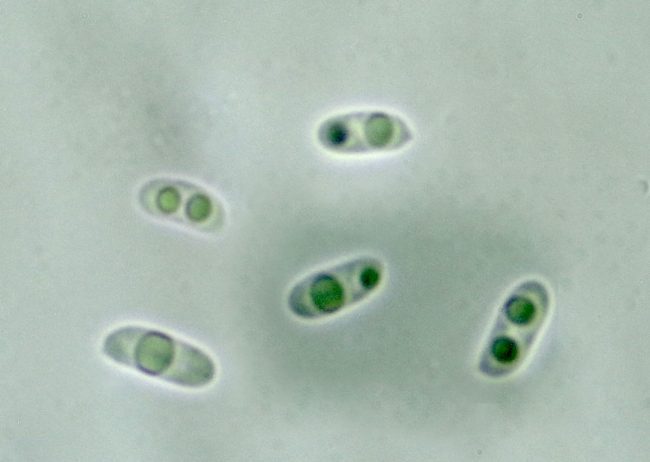
The cylindrical smooth spores of Cinnamon Porecrust
Being able to identify these various types of mysterious but overlooked fungi is one thing. Knowing their role in the larger ecological scheme is another. How common are they? What kind of environments to they favour? Are there particular insects or other organisms that feed specifically on them or their spores?
Do they form fungal associations with other species? Typically, wherever you find a crust, you are almost certain to find other fungi, and often slime moulds too [***]. Some species associate exclusively with other specific species, as in the case of the Yellow Brain jelly fungus that feeds on the mycelium of the Stereum species mentioned in my January post. It seems that in any large fallen tree trunk there exists the hyphae of a large number of fungi growing at any one time, and not all advertise their existence by regularly producing fruiting bodies. Might their presence inhibit or outcompete the growth of other fungi? Yes, this certainly seems to be the case too, and there is already a large degree of research as to how trees inoculated with certain species can serve as protection against more pathogenic rivals.
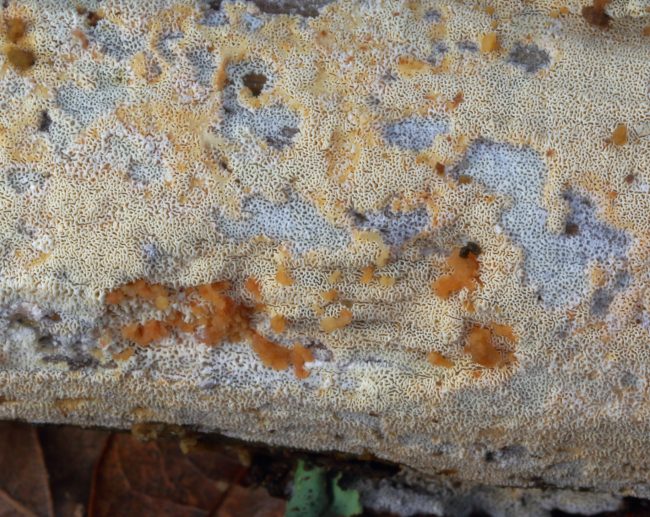
The interesting looking ochre blobs growing on the surface of this Split Porecrust might be an associate fungi with some sort of symbiotic or parasitic relationship to it, but I have been unable to identify it.
There is certainly much to discover, but the information does not seem to be readily available and there are only a relatively small and select group of people even capable of collating and communicating it.
It is still worth keeping your eye out for these cryptic crusts types though, because even if they present a challenging and esoteric domain, when looked at or photographed closely, they can reveal intriguing hidden colours and details and a rare beauty that is not immediately apparent to passers-by. With such a vast array of species out there, you can be sure it this a subject to which I will return in a future post…
Comments are closed for this post.
Discussion
Thanks for this.
I live in the US in the Southern Appalachian Mountains, where I found split porecrust growing on a log in the company of some fruiting crustose lichen and some fruiting black (cyanobacteria-bearing) crustose lichen.
Loved this article. You made things very clear and I appreciate it!

Enjoyed reading this it helped me to identify cinnamon porecrust.
Suzy Webb
3 March, 2023